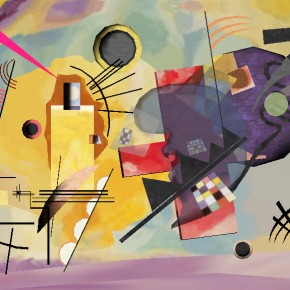
Sophie Lavaud artiste visuelle et chercheure en art numérique interactif
Sophie Lavaud est une artiste française et une théoricienne dans le domaine des arts visuels et de l’image fixe ou en mouvement, photo, vidéo et numérique.
Son travail n’a cessé d’évoluer par l’expérimentation de diverses techniques et supports de représentation graphiques et picturales. Passionnée de peinture et d’histoire de l’art, poussée par le besoin de trouver des modèles de figuration en adéquation avec son époque, elle s’est tournée dès le début des années 90 vers des outils intégrant l’image infographique animée et vers des concepts incorporant les gestes du public à l’œuvre. Ses thématiques de prédilection sont les flux, les mouvements,...

Projet Emergilience (2016 – )
Ma recherche actuelle « en arts » se poursuit sous la forme de productions théoriques et de réalisations pratiques. Le projet artistique Emergilience se propose d’explorer les conditions pour l’émergence de formes par des phénomènes d’auto-organisation. Sa réalisation a commencé avec le stage de Lucien Bobo étudiant de master 2 IC2 A – Art, Science et Technologie (INP Phelma, Ecole Nationale Supérieure de physique, Electronique, Matériaux, Grenoble) en 2016. Stage que j’ai encadré en tant que tuteur et dont j’ai assuré la direction artistique.
Emergence et auto-organisation sont deux notions-clés dans la simulation des systèmes complexes. Pour cela, il est fait appel à...

PUBLICATION : « EMERGILIENCE II » – 30/04/2020
PUBLICATION : « EMERGILIENCE II » – 30/04/2020
Parution en avril 2020 de mon article « Emergilience, un projet de recherche artistique de Sophie Lavaud » dans la revue ISTE, en Sciences humaines et sociales, rubrique : Arts et Sciences.
https://www.openscience.fr/Emergilience-II
Cet article Emergilience II présente ma recherche actuelle « en arts » et fait suite à une première version plus réduite parue dans le n°1 de la même revue en 2017. Le projet Emergilience était programmé pour l’exposition et le colloque international « Arts Ecosystémiques /Architectures Algorithmiques » à l’Ecole Nationale Supérieure d’Architecture de Paris – Val de Seine le 19 mars 2020 mais l’événement a été annulé en raison de...
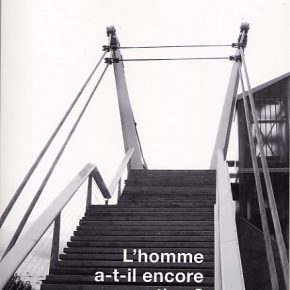
Perspectives numériques. Variabilités, interactions, univers distribués.
Perspectives numériques. Variabilités, interactions, univers distribués.
Par Sophie Lavaud-Forest
Article publié dans la Revue « Communications » n° 85, Editions du Seuil, 2009.
La revue « Communications » est publiée par le Centre Edgar Morin (Ecole des Hautes Etudes en Sciences Sociales). Le n°85 est dirigé par Philippe Mesnard sous le titre « L’homme a-t-il encore une perspective ? »
A la découverte de perspectives renouvelées ?
Toute pratique artistique s’appuie sur des systèmes de représentation qui supposent des techniques et donc des modèles et des théories. Plus que de simples outils à saisir le réel, le circonscrire, en rendre compte, le contrôler, le tenir à distance, s’en approcher, le construire, le...
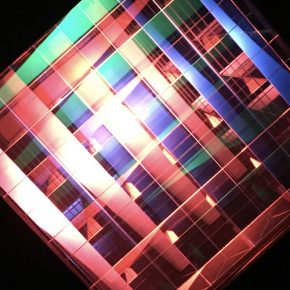
Exposition Julio Le Parc au CDA d’Enghien Les Bains
https://www.paris-art.com/julio-le-parc-centre-des-arts-reels-et-virtuels-1958-2019/
L’exposition de Julio Le Parc intitulée « Réels et Virtuels – 1958 – 2019 » qui a lieu du 20 septembre au 27 décembre 2019 au Centre des Arts d’Enghien Les Bains montre et démontre magistralement le parcours d’un artiste optique qui fait partie de ceux qui ont ouvert la voie aux recherches actuelles comme les miennes.
« Du pigment au pixel » c’est le nom donné à une partie dans le catalogue édité par le CDA à l’occasion de cette exposition. C’est aussi ma devise car c’est le parcours qui m’a menée de la peinture aux installations en Réalité Virtuelle.
L’exposition Julio Le Parc part...
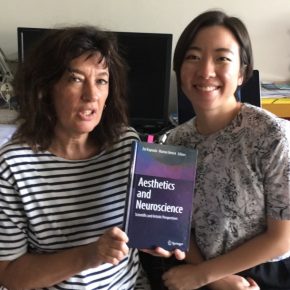
Aesthetics and Neuroscience – Scientific and Artistic Perspectives
Visite à mon domicile de Paris d’Adrienne Lee, venue m’interviewer à propos de mon article « Paintings as Complex Dynamic Systems » publié en anglais aux éditions #Springer dans le livre dirigé par Zoï Kapoula et Marine Vernet : « Aesthetics and Neuroscience – Scientific and Artistic Perspectives ».
https://www.springer.com/gp/book/9783319462325
Adrienne est étudiante à Davidson College en Caroline du Nord, aux Etats-Unis, en deuxième année et troisième à partir d’août prochain avec majeure en #artsvisuels et mineure en #neuroscience qui, bien évidemment, veut créer des œuvres associant #arts et #sciences.
À quand des programmes d’#éducation en arts et sciences en France ? Personnellement je n’ai rien lu qui va dans...

SOIREE DE LANCEMENT DIGIT’ALL ART 23 mai 2019
Soirée de lancement de Digit’all Art, une nouvelle agence d’art digital porteuse de beaux projets très prometteurs pour promouvoir toutes les formes d’art digital et les artistes qui créent ces oeuvres. Je suis la Marraine de l’événement, invitée par Julie Daudignon, sa fondatrice et je serai à ses côtés pour l’accompagner tout au long de cet événement. Nous allons y parler d’art et de technologies numériques, de ma première œuvre interactive Centre-lumière-bleu qui est emblématique du passage du « pigment au pixel » que j’ai opéré dès les années 90 et qui fait maintenant partie de l’histoire de l’art interactif. Et de...
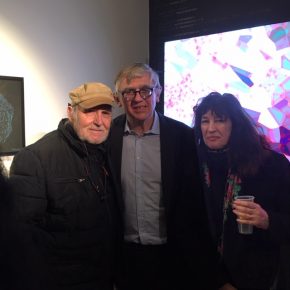
EXPO MIGUEL CHEVALIER A LA GALERIE LELIA MORDOCH
Machine Vision 2019, Miguel Chevalier
Exposition personnelle / Solo Show
Galerie Lélia Mordoch, Paris (France)
Vernissage jeudi 28 mars, de 18h00 à 21h00
Opening on Thursday 28th March 2019, from 6pm to 9pm
Exposition du 29 mars au 25 mai 2019 / Exhibition from 29th March to 25th May 2019
www.leliamordoch.com
Au vernissage de Miguel Chevalier à la galerie Lélia Mordoch jeudi soir, il y avait beaucoup de monde. Du beau monde de l’art contemporain venu admirer les nouvelles créations de cet artiste qui se sert depuis de nombreuses années de l’outil informatique pour créer des formes que seul l’ordinateur a la capacité de calculer. Son exposition solo intitulée Machine...
